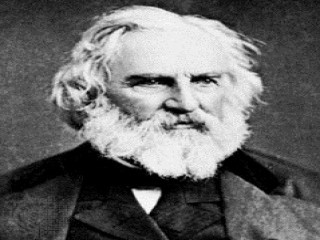
Henry Wadsworth Longfellow biography
Date of birth : 1807-02-27
Date of death : 1882-03-24
Birthplace : Portland, Maine, U.S.
Nationality : American
Category : Historian personalities
Last modified : 2011-06-14
Credited as : Poet, and educator,
Henry Wadsworth Longfellow was born in Portland, Maine, on Feb. 27, 1807, of an established New England family. He attended Portland Academy and then Bowdoin College, graduating in 1825. He was an excellent student whose skill in languages led the trustees at Bowdoin (of which his father was one) to offer the young graduate a professorship of modern languages. He prepared himself further with study abroad (at his own expense) before undertaking his duties.
During Longfellow's 3 years in Europe his lifelong rapport with Old World civilization was firmly established. He returned home in 1829 and 2 years later married Mary Storer Potter. In 1833 he published Outre-Mer: A Pilgrimage beyond the Sea, a collection of picturesque travel essays modeled after Washington Irving's Sketch Book.
In 1834 Longfellow accepted a professorship at Harvard but did not take up his duties until 1837, after he had completed a tour of European and Scandinavian countries. During this trip his wife died. While staying at Heidelberg, he came under the spell of the works of the German romantic poet Novalis, whose moody, mystical nocturnalism struck a responsive chord in the grieving Longfellow. On his return to Cambridge he settled in Craigie House.
In 1839 Longfellow published the sentimental prose romance Hyperion and his first volume of poetry, Voices of the Night. In Hyperion he rather indiscreetly told the story of his pursuit of Frances Appleton, whom he had met in Europe soon after his wife's death. In 1843, after a 7-year courtship, they were married. Her father, a wealthy Boston merchant, gave them Craigie House as a wedding present. This house became a famous visiting place for Longfellow's admirers.
The poem "Hymn to the Night, " in Voices of the Night, conveys Longfellow's debt to Novalis and his romantic kinship with the "calm, majestic presence of the Night." However, "A Psalm of Life, " one of the best-known poems from this first volume, reflects the influence of the famed German poet Johann Wolfgang von Goethe, whose dynamic philosophy suggested to Longfellow the direction of his rather moralizing and trite hymn to action: "Life is real! Life is earnest!/… Be not like dumb, driven cattle!/Be a hero in the strife." Voices of the Night was well received, and within a few years 43, 000 copies had been sold. Long-fellow's audience as a popular writer was assured.
Longfellow's next volume, Ballads and Other Poems (1842), contained two strong narrative poems, "The Wreck of the Hesperus" and "The Skeleton in Armor, " as well as the sentimental verses "Maidenhood" and "The Rainy Day" ("Into each life some rain must fall, / Some days must be dark and dreary") and the moralizing poem "The Village Blacksmith."
After a trip to Europe in 1842 Longfellow published Poems on Slavery (1842) and The Spanish Student: A Play in Three Acts (1843). In 1845 two volumes of poetry appeared: the anthology The Waif, to which Longfellow contributed the poem "The Day Is Done, " and The Belfry of Bruges and Other Poems. Several poems in this second collection reflect Longfellow's deep attachment to the traditions of Old World culture. In addition, this volume contained the popular "The Old Clock on the Stairs, " "The Arrow and the Song, " "The Arsenal at Springfield, " "The Bridge, " and one of his best sonnets, "Mezzo Cammin."
Longfellow achieved a national reputation with the publication of Evangeline (1847), a highly sentimental narrative poem on the expulsion of the French from Acadia. He wrote Evangeline in dactylic hexameters, a meter which in English tends toward monotony and prosiness. Nevertheless, the book was enthusiastically received. Next came the pedestrian romantic novel Kavanagh (1849) and By the Seaside and the Fireside (1850), which contained the very popular nationalistic poem "The Building of the Ship": "Thou, too, sail on, O Ship of State!/ Sail on, O UNION, strong and great!"
In 1854 Longfellow resigned his Harvard professorship to devote himself to his writing career. A year later he published The Song of Hiawatha, a narrative epic poem on the Native American. For this work Longfellow drew on Henry Schoolcraft's books on the Native American; he borrowed the trochaic meter from a Finnish epic. In short order, he repeated the success of Hiawatha with The Courtship of Miles Standish (1858).
Following the tragic death of his second wife in a fire in their home in 1861, Longfellow busied himself with the Tales of a Wayside Inn (1863), in which various speakers, sitting around a fireplace, narrate stories. Other tales appeared in 1872 and 1873. He also completed a major project, his translation of Dante's Divine Comedy (1865-1867).
In the last phase of his long career, Longfellow worked on another major project, The Christus: A Mystery. Completed in 1872, this work was concerned with" various aspects of Christendom in the Apostolic, Middle, and Modern Ages." An earlier work, The Golden Legend (1851), formed part II; part III, The New England Tragedies (1868), dealt with Puritan themes; and, finally, part I, The Divine Tragedy (1871), concerned the life of Christ. Several more volumes of verse were issued before his death on March 24, 1882.
















